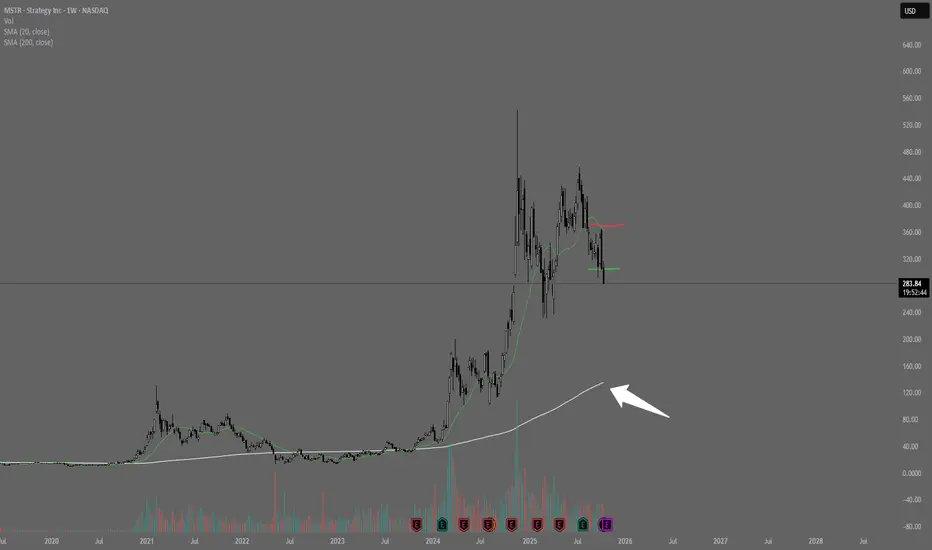When a company builds its balance sheet around Bitcoin, it becomes more than a software firm — it turns into a leveraged bet on BTC itself.
That’s exactly what MicroStrategy (MSTR) has done. And while this strategy paid off massively during Bitcoin’s uptrend, the same dynamic could become a serious liability when the cycle shifts.
1. The Amplified Correlation
MicroStrategy’s market cap is now deeply tied to the value of its Bitcoin holdings.
As BTC rallies, MSTR tends to outperform — sometimes doubling the percentage moves of Bitcoin itself.
But this also means that during downtrends, the drawdowns can be brutal.
In previous cycles, MSTR lost more than 80% of its value as BTC corrected.
2. The Nature of Hidden Leverage
Unlike traditional leverage through debt or derivatives, MSTR’s “leverage” comes from balance-sheet exposure.
The company has repeatedly issued convertible debt and used the proceeds to buy more Bitcoin.
In other words, the stock is effectively a leveraged vehicle on BTC — but with all the operational and financing risks of a public company layered on top.
3. When Sentiment Shifts
During bull markets, investors pile into MSTR as a regulated way to gain exposure to Bitcoin.
But when risk appetite fades, the same crowd exits just as fast.
That double pressure — falling BTC and capital rotation out of crypto — can trigger violent selloffs.
MSTR’s liquidity amplifies this volatility even further.
4. The Structural Risk
At current levels, MSTR’s valuation is heavily dependent on BTC maintaining or expanding its price range.
If Bitcoin consolidates or enters a deeper correction, the company’s debt-fueled exposure could start to weigh heavily.
This is where the “hidden leverage” shows its downside.
Leverage without leverage only works… until the market reminds you that it’s still leverage.
That’s exactly what MicroStrategy (MSTR) has done. And while this strategy paid off massively during Bitcoin’s uptrend, the same dynamic could become a serious liability when the cycle shifts.
1. The Amplified Correlation
MicroStrategy’s market cap is now deeply tied to the value of its Bitcoin holdings.
As BTC rallies, MSTR tends to outperform — sometimes doubling the percentage moves of Bitcoin itself.
But this also means that during downtrends, the drawdowns can be brutal.
In previous cycles, MSTR lost more than 80% of its value as BTC corrected.
2. The Nature of Hidden Leverage
Unlike traditional leverage through debt or derivatives, MSTR’s “leverage” comes from balance-sheet exposure.
The company has repeatedly issued convertible debt and used the proceeds to buy more Bitcoin.
In other words, the stock is effectively a leveraged vehicle on BTC — but with all the operational and financing risks of a public company layered on top.
3. When Sentiment Shifts
During bull markets, investors pile into MSTR as a regulated way to gain exposure to Bitcoin.
But when risk appetite fades, the same crowd exits just as fast.
That double pressure — falling BTC and capital rotation out of crypto — can trigger violent selloffs.
MSTR’s liquidity amplifies this volatility even further.
4. The Structural Risk
At current levels, MSTR’s valuation is heavily dependent on BTC maintaining or expanding its price range.
If Bitcoin consolidates or enters a deeper correction, the company’s debt-fueled exposure could start to weigh heavily.
This is where the “hidden leverage” shows its downside.
Leverage without leverage only works… until the market reminds you that it’s still leverage.
Disclaimer
The information and publications are not meant to be, and do not constitute, financial, investment, trading, or other types of advice or recommendations supplied or endorsed by TradingView. Read more in the Terms of Use.
Disclaimer
The information and publications are not meant to be, and do not constitute, financial, investment, trading, or other types of advice or recommendations supplied or endorsed by TradingView. Read more in the Terms of Use.
